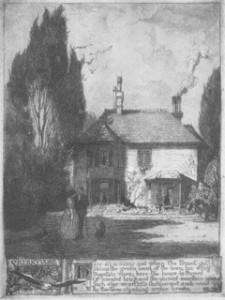“I am now a beastly householder, but have not yet entered on my domain. When I do, the social revolution will probably cast me back upon my dung heap. [. . .] I shall call my house Skerryvore when I get it: SKERRYVORE: c’est bon pour la poeshie”
(Letter from RLS to Edmund Gosse, 12 March 1885, from The Letters of Robert Louis Stevenson, ed. by Bradford A. Booth and Ernest Mehew, vol v [New Haven: Yale University Press, 1995], p. 85)
The Established Author at Bournemouth
RLS and Fanny settled in Bournemouth from July 1884 – August 1887. Stevenson was very ill during this period, often unable to leave the house. Nevertheless, the Bournemouth years marked incredible industry on RLS’s part, when he wrote and published a huge volume of work.
He published “A Humble Remonstrance” (1884), A Child’s Garden of Verses (1885), The Dynamiter (1885), Prince Otto (1885), Jekyll and Hyde (1886), Kidnapped (1886) The Merry Men (1887) and “Pastoral” (1887, later included in Memories and Portraits, published in the same year). Indeed, this period marked the publication of some of his most famous works – RLS was finally becoming a serious author in the public eye.

While working on and publishing the above, he also wrote verses for Underwoods (1887), wrote “Thomas Stevenson: Civil Engineer” ( as a memorial for his father who died in 1887. The essay was later included in Memories and Portraits in 1887) and finished Memoir of Fleeming Jenkin (1888 – Jenkin had passed away in 1885).
Furthermore, he and W.E. Henley, who was a regular visitor to Bournemouth, were constantly working on collaborative projects. RLS and Henley worked on Admiral Guinea (1884), Macaire (1895), and many other ideas during this period.
Homes and Haunts in Bournemouth
When Stevenson and Fanny first arrive in Bournemouth they stayed in the Highcliffe Hotel. They were here from 12-19 July 1884. On the 19th, they moved to lodgings on Sunnington Rise, West Cliff Gardens. They stayed here until September, when they moved to a boarding house, Wensleydale, also in West Cliff Gardens. Fanny and RLS then moved to Bonallie Towers, Branksome Park, where they stayed from November 1884 until March 1885.
In early April 1885, the Stevensons moved to Skerryvore, the house Thomas Stevenson had bought as a wedding gift for Fanny. Skerryvore was on 61 Alum Chine Road, but was destroyed during the Second World War. It was in this house, named after the lighthouse designed by Alan Stevenson, that RLS and Fanny settled for the rest of their stay in Bournemouth. One of the first (and frequent) visitors to Skerryvore was Henry James.
Leaving Bournemouth and the UK
Although Stevenson was extremely ill during the Bournemouth years, he did occasionally leave the city, visiting London, Edinburgh and Dorchester. In August he and Fanny took a two-week holiday to Paris.
In May 1887, RLS and Fanny returned to Edinburgh (staying in York on 5 May) because Thomas Stevenson had become gravely ill. He died on 8 May, and was buried at New Calton Cemetery in Edinburgh on the 13th. Unfortunately, RLS was so unwell he was unable to go to the funeral. He and Fanny returned to Bournemouth in early June.
Shortly afterwards, they began to make preparations for visiting the United States: “Do you know we go to America? It is ordered for my health, will give a change to my mother, and let my wife see her mother. You will think I announce the end of the world (and a different end) every letter” (Letter from RLS to Anne Jenkin, June 1887, from The Letters of Robert Louis Stevenson, ed. by Bradford A. Booth and Ernest Mehew, vol v [New Haven: Yale University Press, 1995], p. 424).
On 20 August 1887, RLS and Fanny left Bournemouth for London. They, along with RLS’s mother, Lloyd, and a maid, Valentine Roch, would leave on the Ludgate Hill bound for New York on 22 August. For more information about RLS’s second trip to the United States, see the USA section.
Just before leaving Bournemouth, RLS wrote tro Sidney Colvin. The letter gives an indication of his hopes for the future and anxieties about what he was leaving behind: “The last day – the last evening – in the old house – with a sad, but God knows, nowise a bitter heart; I wish I could stay with hope” (Letter from RLS to Sidney Colvin, 19 August 1887, from The Letters of Robert Louis Stevenson, ed. by Bradford A. Booth and Ernest Mehew, vol v [New Haven: Yale University Press, 1995], p. 442).
Image from an etching by Leslie M. Ward, by permission of Mr Ernest Cooper, Bournemouth, Robert Louis Stevenson: A Bookman Extra Number (London: Hodder and Stoughton, 1913), p. 64.
